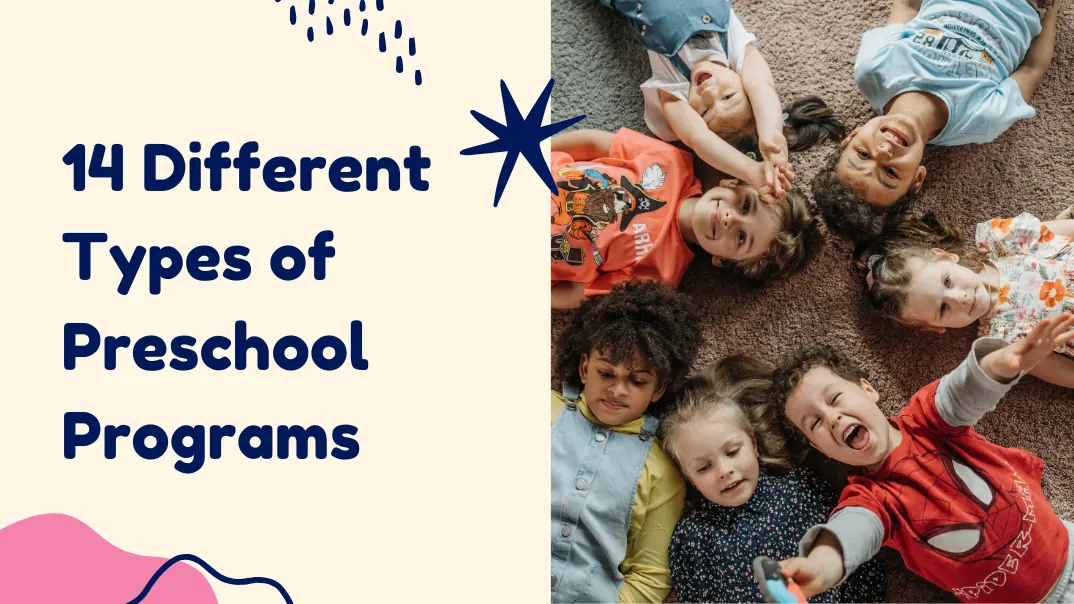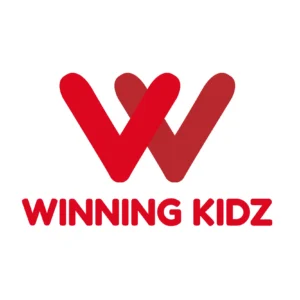قد يكون اختيار روضة الأطفال المناسبة لطفلك مهمة شاقة. مع تعدد الفلسفات والمناهج التعليمية، كيف تختار الأنسب؟ هل أنت قلق بشأن إيجاد برنامج يوازن بين التطور الأكاديمي والاجتماعي؟ ماذا لو لم يكن أسلوب تعلم طفلك مناسبًا للفصول الدراسية التقليدية؟
تقدم برامج ما قبل المدرسة المتنوعة نهجًا فريدًا للتعليم في مرحلة الطفولة المبكرة، يلبي مختلف أنماط التعلم والاحتياجات التنموية. يُعد اختيار برنامج ما قبل المدرسة المناسب لطفلك من أهم القرارات التي يتخذها الوالدان فيما يتعلق بتعليم طفلهما المبكر.
سيُعرّفك هذا الدليل على 14 نوعًا مختلفًا من برامج ما قبل المدرسة. بعد قراءة هذه المقالة، ستفهم بشكل أفضل أي برنامج يُلبي احتياجات طفلك وأهدافه التعليمية.

فهم برامج ما قبل المدرسة
عادةً ما يستهدف برنامج ما قبل المدرسة الأطفال الذين تتراوح أعمارهم بين 3 و5 سنوات، ويساعدهم على تطوير المهارات الأساسية اللازمة للنجاح الأكاديمي لاحقًا. تتراوح هذه البرامج بين بيئات منظمة للغاية وبيئات أكثر استرخاءً، وتقدم أساليب وفلسفات تعليمية متنوعة. إن فهم ما يتضمنه كل برنامج ما قبل المدرسة سيسمح لك باختيار البرنامج الأنسب لاحتياجات طفلك وقيم عائلتك.
ما هو منهج ما قبل المدرسة؟
أ منهج ما قبل المدرسة هو إطار تعليمي مُخطط ومُنظم، مُصمم لتوجيه تعلم وتطور الأطفال الذين تتراوح أعمارهم عادةً بين ثلاث وخمس سنوات. يُغطي البرنامج مجموعةً من المواد الدراسية، بما في ذلك اللغة والرياضيات والعلوم والفنون والدراسات الاجتماعية والمهارات الحركية، ويُتيح للأطفال فرصًا للمشاركة في أنشطة تعليمية تفاعلية وعملية.
عادةً ما تُصمَّم مناهج ما قبل المدرسة لتحقيق التوازن بين احتياجات الأطفال الصغار، مما يسمح لهم بالنمو بوتيرتهم الخاصة مع توفير تحديات مناسبة لأعمارهم تُشجِّع نموهم المعرفي والعاطفي. قد تتضمن برامج ما قبل المدرسة التعلم القائم على اللعب والتعلم المنظم، مُقدِّمةً أساليب متنوعة لتعزيز الإبداع وحل المشكلات والمهارات الاجتماعية.
لماذا يعد برنامج ما قبل المدرسة الشامل مهمًا؟
يُعدّ برنامج ما قبل المدرسة الشامل أمرًا بالغ الأهمية لأنه يُعنى بالنمو الشامل للطفل. فإلى جانب إكسابه المهارات الأكاديمية الأساسية، تُنمّي هذه البرامج الكفاءات الاجتماعية، والمرونة العاطفية، والتنسيق الحركي. تشير الأبحاث إلى أن الأطفال الذين يلتحقون ببرامج ما قبل المدرسة عالية الجودة يُظهرون استعدادًا أفضل للمدرسة، وأداءً أكاديميًا أفضل، وسلوكيات اجتماعية مُحسّنة. علاوة على ذلك، يُمكن أن يُقلّل التعرّض المُبكر لبيئات تعليمية مُنظّمة من الحاجة إلى خدمات التعليم الخاص، ويزيد من معدلات التخرج من المدرسة الثانوية. لذا، فإن الاستثمار في تجربة ما قبل المدرسة مُتكاملة يُمهّد الطريق لنجاح مُستمر مدى الحياة.

أنواع برامج ما قبل المدرسة: ما تحتاج إلى معرفته
اختيار برنامج ما قبل المدرسة المناسب لطفلك يتطلب فهم الأنواع المتاحة. تختلف برامج ما قبل المدرسة في فلسفتها وبنيتها ومنهجها. يركز بعضها بشكل كبير على اللعب و المهارات الاجتماعيةبينما قد يُعطي آخرون الأولوية للاستعداد الأكاديمي. فهم هذه الأنواع يُساعد في تحديد البرنامج الذي يُناسب احتياجات طفلك وقيمه التعليمية.
تتضمن بعض العوامل الرئيسية التي يجب مراعاتها عند استكشاف برامج ما قبل المدرسة ما يلي:
- فلسفة التدريس في البرنامج
- دور التفاعل بين المعلم والطالب
- التوازن بين التعلم المنظم واللعب الحر
- يركز البرنامج على النمو الاجتماعي والعاطفي
- فرص مشاركة الوالدين

أفضل 14 نوع من برامج ما قبل المدرسة
يقدم كل برنامج من برامج ما قبل المدرسة مزايا وفرصًا تعليمية فريدة للأطفال الصغار. إن فهم الخصائص الرئيسية لكل برنامج يساعدك على تحديد البرنامج الأنسب لاحتياجات طفلك التنموية وقيم عائلتك.
1. برنامج مونتيسوري لمرحلة ما قبل المدرسة
يعتمد برنامج مونتيسوري لمرحلة ما قبل المدرسة على الفلسفة التربوية للدكتورة ماريا مونتيسورييركز هذا النهج المُركّز على الطفل على تشجيع الاستقلالية والتوجيه الذاتي والتفكير النقدي. الأطفال في تخطيطات الفصول الدراسية في مونتيسوري يمكن للأطفال اختيار أنشطتهم، مما يعزز حب التعلم بوتيرتهم الخاصة. بيئة التعلم مُجهزة بعناية، ومواد مصممة خصيصًا تشجع الأطفال على المشاركة والاستكشاف باستقلالية.
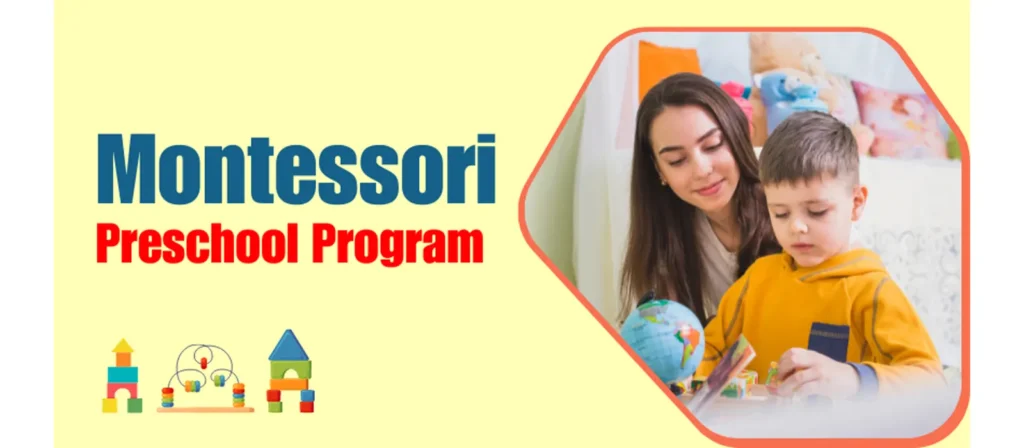
مميزات برامج مونتيسوري لمرحلة ما قبل المدرسة:
- التعلم بقيادة الطفل
- التعليم الفردي
- الفصول الدراسية المختلطة الأعمار
- التركيز على مهارات الحياة العملية والاستقلال
- التركيز على التعلم العملي
مونتيسوري: المزايا والعيوب
| المزايا | العيوب |
|---|---|
| يشجع الاستقلال والانضباط الذاتي | قد لا يناسب الأطفال الذين يحتاجون إلى مزيد من الهيكل |
| تعزيز الإبداع ومهارات حل المشكلات | عدم التركيز على الأنشطة التنافسية |
| يسمح بوتيرة التعلم الفردية | المنافسة الاجتماعية المحدودة والتفاعل الجماعي |
| الفصول الدراسية المختلطة الأعمار تعزز التعلم بين الأقران | قد تؤدي النسبة العالية من المعلمين إلى الأطفال إلى الحد من الاهتمام الفردي |
| الأنشطة العملية تشرك الأطفال بنشاط | قد تكون باهظة الثمن بسبب المواد المتخصصة |
2. برنامج ريجيو إميليا لمرحلة ما قبل المدرسة
ال نهج ريجيو إميليا أسلوب تعليمي بنائي يركز على الطالب، ويشجع الأطفال على استكشاف بيئتهم والتعبير عن أفكارهم من خلال وسائل متنوعة. نشأ هذا الأسلوب في إيطاليا، وينظر إلى الأطفال على أنهم كفؤون، فضوليون، وقادرون على بناء تجاربهم التعليمية الخاصة. يعمل المعلمون كمرشدين أو ميسرين، يدعمون اهتمامات الأطفال ويعززون بيئة تعليمية تعاونية.
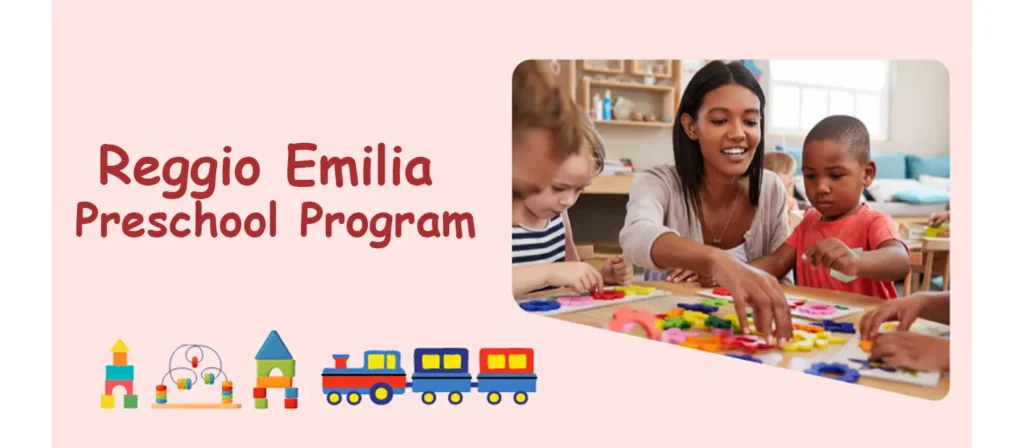
مميزات برامج ما قبل المدرسة في ريجيو إميليا:
- التركيز على التعلم التعاوني القائم على المشاريع
- التركيز على الإبداع والتعبير الفني
- مشاركة قوية من الوالدين
- المعلمون كميسرين وليسوا مدربين
- التعلم من خلال الاستكشاف والاستفسار
ريجيو إميليا: المزايا والعيوب
| المزايا | العيوب |
|---|---|
| يعزز الإبداع والتفكير النقدي | يتطلب تدريبًا وخبرة واسعة للمعلم |
| التركيز القوي على التطور الاجتماعي والعاطفي | قد يكون من الصعب على الآباء فهمه بسبب طبيعته غير التقليدية |
| يشجع العمل الجماعي والتعاون | قد لا تكون مناسبة للأطفال الذين يزدهرون في البيئات المنظمة |
| نهج فردي للغاية للتعلم | التركيز بشكل أقل على المواد الأكاديمية التقليدية مثل القراءة والكتابة |
| يدمج مشاركة الأسرة في عملية التعلم | يتطلب مواد وموارد واسعة النطاق |
3. برنامج ما قبل المدرسة في مدرسة والدورف
تعليم والدورف، الذي أسسه رودولف شتاينريركز برنامج والدورف على تنمية إبداع الطفل وخياله وصحته النفسية. يعتمد المنهج على سرد القصص والفنون والأنشطة المرتبطة بالطبيعة. تُركز رياض الأطفال والدورف على الإيقاع والروتين، مما يُوفر شعورًا بالأمان للأطفال الصغار. تُقدم المواد الدراسية لاحقًا، بعد إرساء الأسس العاطفية والاجتماعية.

مميزات برامج ما قبل المدرسة في مدرسة والدورف:
- التركيز على الفنون والإبداع
- رواية القصص واللعب الخيالي
- التركيز على التطور الأخلاقي والعاطفي
- بيئات التعلم القائمة على الطبيعة
- منهج دراسي مناسب للنمو
والدورف: المزايا والعيوب
| المزايا | العيوب |
|---|---|
| يعزز الإبداع والنمو العاطفي | عدم التركيز على التحصيل الدراسي في السنوات الأولى |
| التركيز على التنمية الشاملة، بما في ذلك النمو البدني والعاطفي والروحي | قد لا يكون هذا الإعداد مناسبًا لإعداد الأطفال للظروف الأكاديمية المنظمة للغاية |
| التركيز القوي على الفنون والخيال | التعرض المحدود للتكنولوجيا والأدوات التعليمية الحديثة |
| يشجع على الارتباط العميق بالطبيعة | التكلفة العالية في بعض المناطق |
| بناء روابط مجتمعية قوية من خلال العلاقات بين المعلمين وأولياء الأمور | قد يكون بطيئًا في التكيف مع الاتجاهات التعليمية الجديدة |
4. برنامج ما قبل المدرسة التقليدي
تتميز رياض الأطفال التقليدية عمومًا بهيكلية أكثر تنظيمًا. فهي تركز على إعداد الأطفال لمرحلة رياض الأطفال، وتركز على المهارات الأكاديمية الأساسية كالقراءة والكتابة والحساب والسلوك الاجتماعي. وغالبًا ما تتبع هذه البرامج منهجًا ثابتًا يتضمن أنشطةً يقودها المعلمون، مما يوفر بيئةً تعليميةً مستقرةً يتعلم فيها الأطفال المهارات الأساسية في بيئةٍ أكثر رسمية.
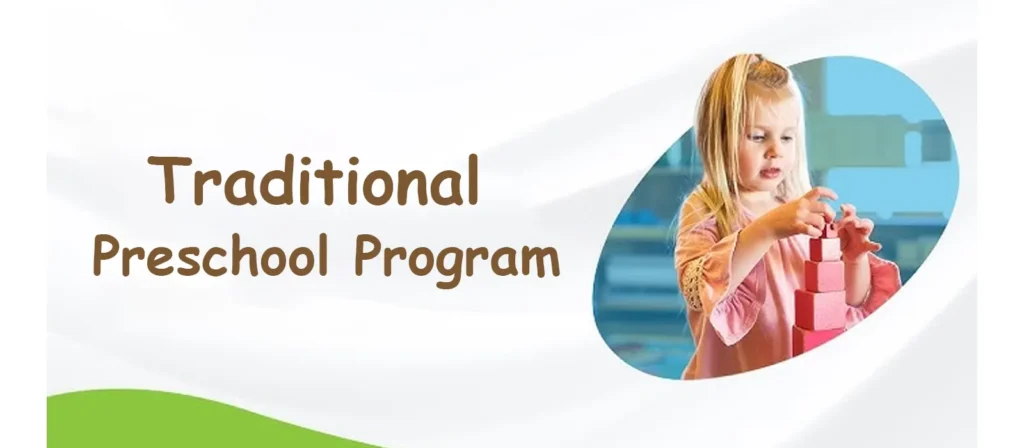
مميزات برامج ما قبل المدرسة التقليدية:
- منهج دراسي منظم
- التركيز على مهارات الاستعداد للمدرسة
- التعليم بقيادة المعلم
- التركيز على الأساسيات الأكاديمية (القراءة والكتابة والرياضيات)
- الروتين والبيئة المتوقعة
التقليدي: المزايا والعيوب
| المزايا | العيوب |
|---|---|
| التركيز القوي على إعداد الأطفال للمدرسة | التركيز بشكل أقل على الإبداع والخيال |
| تساعد بيئة التعلم المنظمة الأطفال على التكيف مع البيئات المدرسية | قد لا يسمح بأنماط التعلم الفردية |
| يساعد التركيز الأكاديمي الواضح الأطفال على الاستعداد للقراءة والرياضيات | يمكن أن تكون صارمة وأقل مرونة في التعامل |
| روتينات متوقعة ومريحة للأطفال | لا يوجد قدر كبير من التعلم العملي مقارنة بالطرق الأخرى |
| إعداد الأطفال لنظام مدرسي أكثر رسمية | يمكن أن يحد من فرص التعبير عن الذات |
5. برنامج هاي سكوب لمرحلة ما قبل المدرسة
ال نهج HighScope يعتمد برنامج هاي سكوب على التعلم التشاركي النشط. يُشجَّع الأطفال على التفاعل مع بيئتهم، وتخطيط الأنشطة، واتخاذ القرارات، والتأمل في تجاربهم. يُركّز المنهج على عملية "التخطيط، التنفيذ، المراجعة"، مما يُشجّع الأطفال على تحمّل مسؤولية تعلّمهم. كما يُركّز هاي سكوب على تطوير المهارات الاجتماعية والأكاديمية والمعرفية بطريقة عملية وتفاعلية.

مميزات برامج ما قبل المدرسة HighScope:
- عملية التعلم "التخطيط والتنفيذ والمراجعة"
- التركيز على التعلم النشط
- التركيز على التطور الاجتماعي والمعرفي
- يتخذ الأطفال خيارات ويتحملون مسؤولية تعليمهم
- الروتين والأنشطة اليومية المنظمة
HighScope: المزايا والعيوب
| المزايا | العيوب |
|---|---|
| يشجع الاستقلال وحل المشكلات | يتطلب طاقم عمل مدرب وذو خبرة عالية |
| يساعد التعلم النشط على إشراك الأطفال في تعليمهم | قد لا يناسب الأطفال الذين يفضلون بيئة تعليمية أكثر سلبية |
| التركيز القوي على التطور الاجتماعي والمعرفي | يمكن أن تكون صارمة في تنفيذ روتيناتها |
| نهج التعلم الفردي | يتطلب مشاركة كبيرة من الوالدين |
| يعزز التفكير النقدي واتخاذ القرار | التعرض المحدود للمهارات الأكاديمية التقليدية |
6. برنامج التعاون بين الوالدين لمرحلة ما قبل المدرسة
في تعاونيات أولياء الأمور، يشارك أولياء الأمور في إدارة المدرسة اليومية، بما في ذلك واجبات التدريس والمهام الإدارية والدعم العام. يعزز هذا النموذج روحًا مجتمعية قوية، ويشجع أولياء الأمور على المشاركة الفعالة في التعليم المبكر لأطفالهم. ونظرًا لمستوى المشاركة العالي لأولياء الأمور، تقدم تعاونيات أولياء الأمور عادةً رعايةً واهتمامًا شخصيًا أكثر.
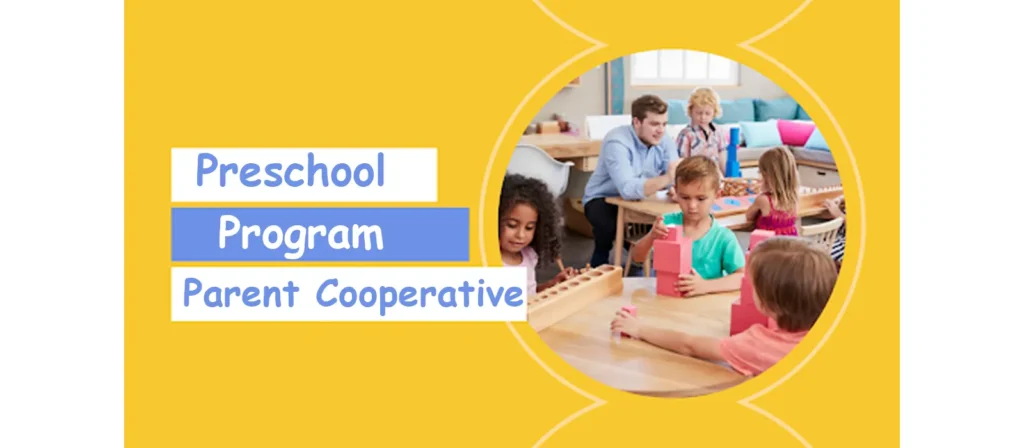
مميزات برامج التعاون بين الوالدين لمرحلة ما قبل المدرسة:
- مشاركة عالية من الوالدين
- يساهم الآباء في التدريس وإدارة المدرسة
- التركيز على بناء المجتمع
- التركيز على التعلم التعاوني
- أحجام الفصول الدراسية صغيرة
التعاونيات الأبوية: المزايا والعيوب
| المزايا | العيوب |
|---|---|
| شعور قوي بالانتماء للمجتمع والمشاركة | يتطلب التزامًا زمنيًا كبيرًا من الوالدين |
| اهتمام شخصي بسبب أحجام الفصول الدراسية الصغيرة | قد يكون من الصعب على الآباء العاملين الالتزام بمتطلبات الوقت |
| يستفيد الأطفال من التعرض المستمر للوجوه المألوفة | يمكن أن يسبب التوتر للآباء الذين قد يشعرون بالإرهاق من مسؤولياتهم |
| بأسعار معقولة في كثير من الحالات | محدودة بسبب توافر مدارس ما قبل المدرسة التعاونية في بعض المناطق |
| يعزز العلاقات القوية بين الوالدين والطفل | قد يفتقر إلى الخبرة المهنية للمعلمين المدربين تدريباً كاملاً |
7. برنامج ما قبل المدرسة القائم على الدين أو المعتقد
تُدمج رياض الأطفال ذات التوجه الديني التعاليم الروحية في مناهجها التعليمية، مع التركيز غالبًا على التنمية الأخلاقية. تهدف هذه البرامج إلى تعزيز التعلم الأكاديمي والنمو الروحي من خلال منهج يتماشى مع المعتقدات الدينية للمدرسة أو المجتمع. يُعلّم الأطفال قصص دينيةوالقيم والتقاليد إلى جانب المواد الدراسية التقليدية لمرحلة ما قبل المدرسة.
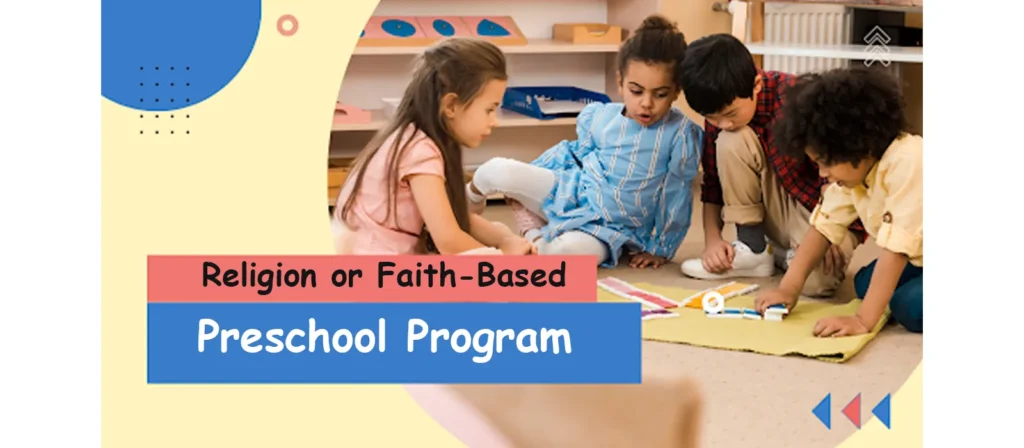
مميزات برامج ما قبل المدرسة الدينية أو القائمة على الإيمان:
- دمج التعاليم الدينية
- التركيز على التطور الأخلاقي والروحي
- التركيز على قيم المجتمع والأسرة
- غالبًا ما يعكس المنهج الدراسي تقاليد ومعتقدات ديانة معينة
- تشمل الصلاة والاحتفالات الدينية
الدين أو المعتقد: المزايا والعيوب
| المزايا | العيوب |
|---|---|
| يوفر أساسًا أخلاقيًا وروحيًا قويًا | قد لا تكون مناسبة للعائلات التي لا تؤمن بنفس العقيدة |
| يشجع الروابط المجتمعية القوية | قد يكون الأمر مقيدًا إذا كانت العائلات لديها وجهات نظر دينية مختلفة |
| يساعد الأطفال على تنمية الشعور بالانتماء | قد يفتقر إلى التنوع في أساليب التدريس أو وجهات النظر |
| يركز على تطوير الشخصية إلى جانب الجانب الأكاديمي | التعرض المحدود للأفكار الدينية أو الثقافية الأخرى |
8. برنامج ما قبل المدرسة في شارع بنك
يركز نهج بنك ستريت في تعليم ما قبل المدرسة على نموذج التفاعل التنموي، حيث ينخرط الأطفال بنشاط في بيئة تعليمية تعزز نموهم المعرفي والعاطفي. يركز هذا النهج على التعلم التجريبي، ويشجع الأطفال على التفاعل الهادف مع بيئتهم وأقرانهم ومعلميهم. يعمل المعلمون كميسرين، يوجهون فضول الأطفال ويساعدونهم على استكشاف عالمهم من خلال أنشطة عملية.
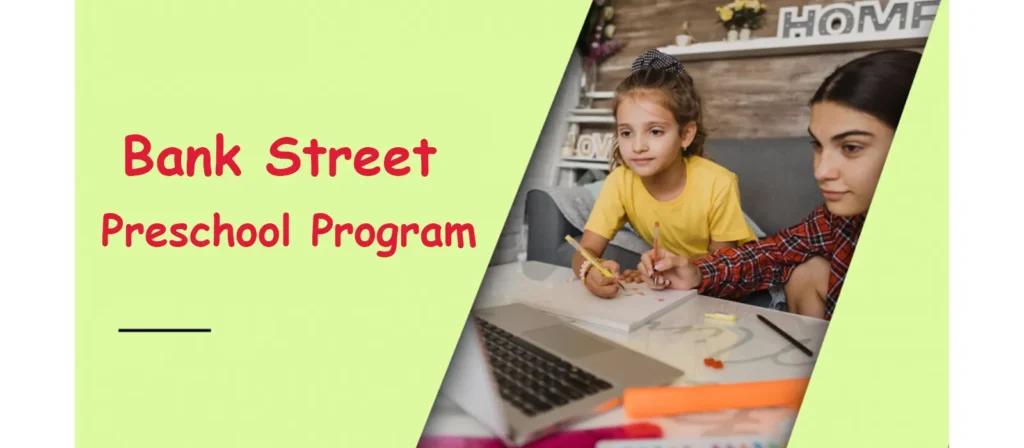
مميزات برامج ما قبل المدرسة في بنك ستريت:
- التعلم التنموي الذي يركز على الطفل
- التركيز على التطور الاجتماعي والعاطفي
- التعلم القائم على المشاريع
- التعلم العملي والتجريبي
- بيئة التعلم التعاوني
شارع البنك: المزايا والعيوب
| المزايا | العيوب |
|---|---|
| يشجع التعاون والتفاعل الاجتماعي | قد يكون الأمر صعبًا بالنسبة للأطفال الذين يحتاجون إلى مزيد من الهيكل أو الإشراف |
| يعزز الفهم العميق للمفاهيم من خلال الاستكشاف | يمكن أن تكون كثيفة الموارد من حيث المواد والتخطيط |
| يدعم تطوير المهارات الاجتماعية والمعرفية | غير مناسب للأطفال الذين يحتاجون إلى إرشادات أو قواعد واضحة |
| بناء مهارات حل المشكلات والتفكير النقدي | غير مناسب للأطفال الذين يحتاجون إلى إرشادات أو قواعد واضحة للغاية |
9. برنامج أسيند لمرحلة ما قبل المدرسة
تُركز برامج أسيند لمرحلة ما قبل المدرسة على إعداد الأطفال للنجاح في المجال الأكاديمي، مع رعاية نموهم العاطفي والاجتماعي والأخلاقي. يدمج نهج أسيند المواد الأكاديمية مع أنشطة بناء الشخصية لتوفير تعليم متكامل. غالبًا ما تستخدم مدارس أسيند مزيجًا من الأنشطة المنظمة واللعب الحر لخلق تجربة تعليمية متوازنة.

مميزات برامج حضانة أسيند:
- التركيز على بناء القيم الأخلاقية والأخلاقية.
- التحضير للتحديات الأكاديمية المستقبلية.
- التركيز على التطور البدني والاجتماعي والعاطفي والفكري.
- أهداف تعليمية محددة بوضوح في كل من المستوى الأكاديمي والنمو الشخصي.
- منهج دراسي منظم ومرن
الصعود: المزايا والعيوب
| الايجابيات | سلبيات |
|---|---|
| يوفر نهجًا متوازنًا للتنمية الأكاديمية والشخصية | قد يكون التركيز أكاديميًا للغاية بالنسبة لبعض الأطفال في مرحلة ما قبل المدرسة |
| إعداد الأطفال للتحديات الأكاديمية المستقبلية | ربما يكون التركيز أكاديميًا للغاية بالنسبة لبعض الأطفال في مرحلة ما قبل المدرسة |
| يركز على بناء الشخصية والمرونة | قد يكون الأمر صعبًا بالنسبة للأطفال الذين يحتاجون إلى مزيد من الاهتمام الفردي |
| يشجع المسؤولية الاجتماعية وبناء المجتمع | يتطلب مشاركة فعالة من الآباء والمعلمين |
10. برنامج ما قبل المدرسة القائم على اللعب
قائم على اللعب تُركز رياض الأطفال على التعلم من خلال اللعب، مُدركةً أهمية اللعب في نمو الطفل. في هذه البرامج، يُشارك الأطفال في لعب مُنظم وغير مُنظم، مُعززين نموهم الاجتماعي والعاطفي والمعرفي والجسدي. يُرشد المعلمون التعلم القائم على اللعب من خلال توفير مواد وأنشطة مُتنوعة تُشجع على الاستكشاف وحل المشكلات والتعاون.

مميزات برامج ما قبل المدرسة القائمة على اللعب:
- التركيز على التعلم من خلال اللعب
- يشارك الأطفال في أنشطة اللعب المنظمة وغير المنظمة
- يعزز التطور الاجتماعي والعاطفي والمعرفي والجسدي
- فرص التعلم العملي والتجريبي
- يقوم المعلمون بإرشاد الأطفال ومراقبة لعبهم
اللعب القائم على اللعب: المزايا والعيوب
| المزايا | العيوب |
|---|---|
| يشجع الإبداع والاستقلال وحل المشكلات | قد لا يهيئ الأطفال للبيئات المدرسية الرسمية |
| تعزيز التفاعل الاجتماعي والعمل الجماعي | قد يفتقر إلى التركيز على الاستعداد الأكاديمي |
| يوفر بيئة تعليمية ممتعة وجذابة | قد لا يفهم جميع الآباء قيمة التعلم القائم على اللعب |
| يشجع التطور العاطفي والاجتماعي | قد يواجه بعض الأطفال صعوبة في التعامل مع البيئة الأقل تنظيماً |
| يدعم تطوير المهارات الحركية | يتطلب معلمين ماهرين لتسهيل اللعب بشكل فعال |
11. برنامج ما قبل المدرسة الناشئ
برامج ما قبل المدرسة الناشئة هي نماذج مبتكرة تجمع بين عناصر من أطر تعليمية راسخة، مثل مونتيسوري وريجيو إميليا، والتعلم القائم على اللعب. تهدف هذه البرامج إلى التكيف مع الاحتياجات التعليمية المتطورة للأطفال الصغار، وغالبًا ما تدمج التكنولوجيا الحديثة والاستدامة البيئية والوعي العالمي في مناهجها. تتميز هذه البرامج بمرونة عالية، وغالبًا ما تُجرّب مناهج تربوية جديدة تستند إلى أبحاث مستمرة وملاحظات من المعلمين وأولياء الأمور والأطفال.

مميزات برامج ما قبل المدرسة الناشئة:
- دمج الأدوات التعليمية الحديثة والتكنولوجيا
- التركيز على الوعي العالمي والاستدامة
- مزيج من المناهج التعليمية المتعددة
- القدرة على التكيف بناءً على الأبحاث الحالية وردود الفعل
- التركيز على الإبداع والاستقصاء والتفكير النقدي
الناشئة: المزايا والعيوب
| المزايا | العيوب |
|---|---|
| نهج مبتكر لتعليم الطفولة المبكرة | غالبًا ما تكون تجريبية وقد تفتقر إلى سجل حافل مثبت |
| يتضمن مفاهيم التكنولوجيا والاستدامة | قد لا تكون متاحة على نطاق واسع أو يمكن الوصول إليها |
| يتكيف بسرعة مع الاتجاهات التعليمية والبحوث الجديدة | يتطلب تحديثات وتعديلات مستمرة للمناهج الدراسية |
| يوفر تجربة تعليمية متنوعة وواسعة النطاق | قد يكون هناك تناقض في التنفيذ عبر البرامج المختلفة |
| يشجع الإبداع والاستكشاف والتفكير النقدي | التكلفة العالية بسبب التكنولوجيا والموارد الجديدة |
12. برنامج ما قبل المدرسة في مدرسة الغابة
مدارس الغابات هي نموذج تعليمي قائم على الأنشطة الخارجية، يُغمر الأطفال في بيئات طبيعية، مما يتيح لهم التعلم من خلال التفاعل المباشر مع الطبيعة. تُركز هذه البرامج على اللعب والاستكشاف والنشاط البدني، مما يُساعد الأطفال على تنمية المرونة والثقة بالنفس وتعميق ارتباطهم بالبيئة. غالبًا ما تتضمن مدارس الغابات بناء الملاجئ، والمشي لمسافات طويلة، ودراسة الحياة البرية، مما يُعزز مهارات حل المشكلات والتعاون.
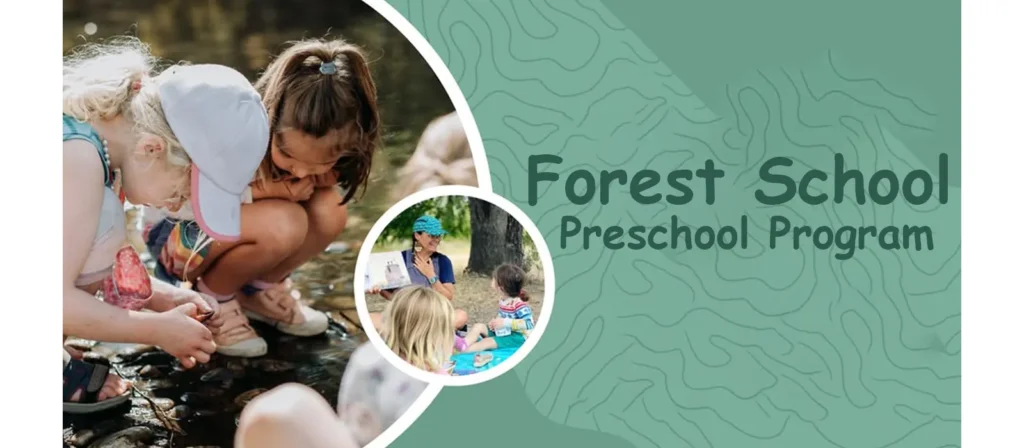
مميزات برامج مدرسة الغابة:
- يتم التعلم في المقام الأول في الهواء الطلق في البيئات الطبيعية
- التركيز على الأنشطة البدنية وحل المشكلات والعمل الجماعي
- يعزز الارتباط القوي بالطبيعة والوعي البيئي
- يطور المرونة والثقة والاستقلالية
- التركيز على اللعب غير المنظم والاستكشاف
مدرسة الغابة: المزايا والعيوب
| المزايا | العيوب |
|---|---|
| يبني المرونة والثقة والاستقلال | قد يكون من الصعب تنفيذه في المناطق الحضرية أو غير الريفية |
| يعزز الارتباط القوي بالطبيعة والمسؤولية البيئية | قد تؤدي الظروف الجوية إلى تعطيل البرنامج |
| يشجع النشاط البدني واللعب في الهواء الطلق | قد لا توفر نفس القدر من البنية الأكاديمية مثل نماذج ما قبل المدرسة الأخرى |
| تعزيز مهارات حل المشكلات والعمل الجماعي | قد لا يشعر كل طفل بالراحة في بيئة خارجية أقل تنظيماً |
| يعزز الصحة العقلية والجسدية | قد يتطلب موارد إضافية وتدريبًا للمعلمين |
13. برنامج هيد ستارت لمرحلة ما قبل المدرسة
برنامج "هيد ستارت" هو برنامج ممول اتحاديًا في الولايات المتحدة الأمريكية، يوفر تعليمًا في مرحلة الطفولة المبكرة للأطفال والأسر ذات الدخل المحدود. يركز البرنامج على الاستعداد للمدرسة من خلال تقديم خدمات شاملة تشمل التعليم والصحة والتغذية ودعم الأسرة. صُممت برامج "هيد ستارت" لتلبية احتياجات الأطفال من الولادة وحتى سن الخامسة، وتهدف إلى المساعدة في سد فجوة التحصيل الدراسي لدى الأطفال من خلفيات اقتصادية محرومة.
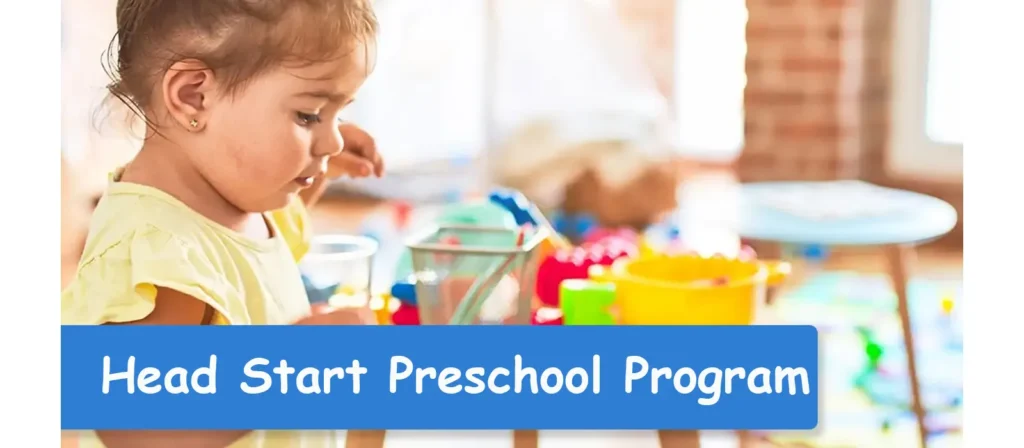
مميزات برامج Head Start:
- ممول على المستوى الفيدرالي وموجه للأسر ذات الدخل المنخفض
- يقدم تعليم الطفولة المبكرة إلى جانب الخدمات الصحية والتغذية والأسرة
- التركيز على جاهزية المدرسة والاستعداد الأكاديمي
- منهج دراسي متجاوب ثقافيًا لتلبية الاحتياجات المتنوعة
- التركيز على مشاركة الوالدين
برنامج Head Start: المزايا والعيوب
| المزايا | العيوب |
|---|---|
| يوفر تعليمًا مبكرًا مجانيًا أو منخفض التكلفة للأسر ذات الدخل المنخفض | توفر محدود بسبب متطلبات الأهلية |
| خدمات شاملة، بما في ذلك الدعم الصحي والتغذوي | قد لا توفر قدرًا كبيرًا من الاهتمام الفردي بسبب أحجام الفصول الدراسية الكبيرة |
| التركيز على سد فجوة الإنجاز للأطفال المعرضين للخطر | مرونة أقل في تصميم البرنامج وتنفيذه |
| يشجع مشاركة الوالدين وانخراطهم | قد لا تتوافق مع الفلسفات التعليمية لجميع العائلات |
| إعداد الأطفال للنجاح الأكاديمي في المستقبل | قد يكون مستهلكًا للموارد بالنسبة للمسؤولين |
14. برنامج الغمر اللغوي لمرحلة ما قبل المدرسة
تُركز رياض الأطفال التي تُقدم برامج الغمر اللغوي على تعليم الأطفال لغة ثانية من خلال غمرهم في بيئة تُتحدث فيها اللغة المستهدفة طوال اليوم. صُممت هذه البرامج لمساعدة الأطفال على تطوير مهارات ثنائية أو متعددة اللغات في مرحلة مبكرة من حياتهم، مما يُوفر فوائد معرفية مثل تحسين الذاكرة، والقدرة على حل المشكلات، والمرونة العقلية. غالبًا ما تُركز برامج الغمر اللغوي على التعلم الطبيعي من خلال المحادثات اليومية والأغاني والأنشطة التي تُقام باللغة الثانية.
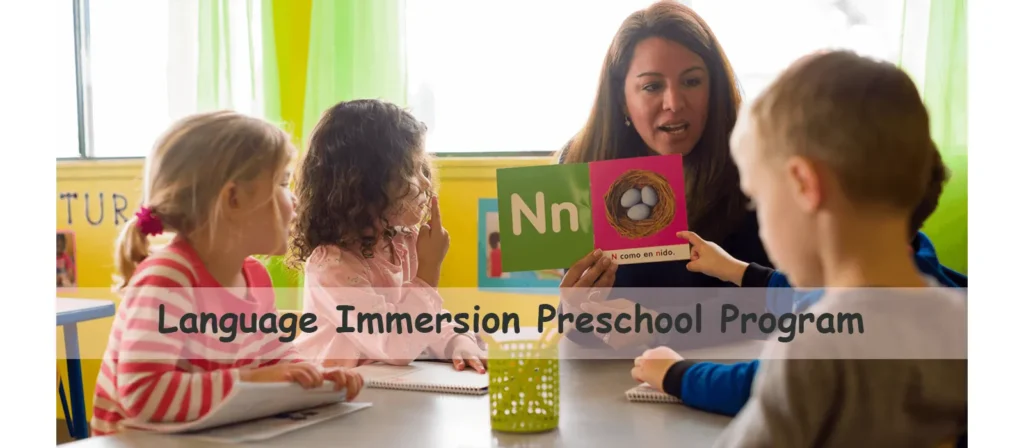
مميزات برامج الغمر اللغوي لمرحلة ما قبل المدرسة:
- التركيز على تعلم لغة ثانية من خلال الانغماس
- بيئة غنية باللغة حيث يتم التحدث باللغة الثانية بانتظام
- يتعلم الأطفال من خلال اللعب والأغاني والأنشطة التفاعلية
- غالبًا ما يتضمن التعرض للتقاليد الثقافية المرتبطة باللغة
- يستخدم عادةً نهجًا ثنائي اللغة، حيث يتقن المعلمون كلتا اللغتين
الانغماس اللغوي: المزايا والعيوب
| الايجابيات | سلبيات |
|---|---|
| يعزز ثنائية اللغة والمرونة المعرفية | قد يكون الأمر صعبًا بالنسبة للأطفال الذين يعانون من صعوبات في اكتساب اللغة |
| يشجع الوعي الثقافي والفهم | يتطلب معلمين ذوي مهارات عالية يجيدون اللغتين |
| يعزز الذاكرة والانتباه ومهارات حل المشكلات | قد يعاني بعض الأطفال من ارتباك أو تأخير في اللغة في البداية |
| يوفر ميزة في تعلم اللغة في المستقبل | التوفر محدود في بعض المناطق الجغرافية |
أرسل لنا رسالة إذا كان لديك أي أسئلة أو اطلب عرض أسعار. سيقدم لك خبرائنا الرد خلال 48 ساعة ويساعدونك في اختيار المنتج المناسب الذي تريده.
كيف نشجع الآباء على تسجيل أبنائهم في برنامج التعليم في مرحلة الطفولة المبكرة؟
إقناع الآباء بتسجيل أطفالهم في برنامج تعليم الطفولة المبكرة يتطلب أكثر من مجرد شرح المنهج، بل يتعلق الأمر بجعلهم يشعرون بالراحة والطمأنينة بأن هذا القرار سيضمن نجاح طفلهم.
1. اشرح فوائد برامج التعليم المبكر
من الاستراتيجيات الرئيسية لتشجيع أولياء الأمور على تسجيل أطفالهم في برنامج تعليم الطفولة المبكرة شرح فوائده بوضوح. يُعزز التعليم المبكر المهارات المعرفية الأساسية، وتطور اللغة، والكفاءات الاجتماعية التي تُساعد الأطفال على التكيف مع البيئات المدرسية. وتُشير الأبحاث باستمرار إلى أن الأطفال الذين يلتحقون بمدارس رياض الأطفال عالية الجودة يُحققون أداءً أكاديميًا واجتماعيًا أفضل طوال مسيرتهم التعليمية.
2. تسليط الضوء على مزايا برامج ما قبل المدرسة
من الأسباب الوجيهة الأخرى لتشجيع أولياء الأمور على تسجيل أطفالهم في رياض الأطفال البيئة المنظمة التي توفرها. توفر برامج رياض الأطفال للأطفال روتينًا متوازنًا بين التعلم واللعب. يتعلم الأطفال في هذه البيئات المهارات الأكاديمية الأساسية، مثل القراءة والكتابة والحساب، بينما يطورون ذكائهم العاطفي والاجتماعي.
3. توفير جولات في المرافق
لتخفيف قلق أولياء الأمور، يُمكن أن يُحدث عرض جولة في مرافق رياض الأطفال تأثيرًا كبيرًا. تُتيح جولة في المدرسة، تُسلّط الضوء على الفصول الدراسية ومواد التعلم والمساحات الخارجية، لأولياء الأمور رؤية البيئة التي سيقضي فيها أطفالهم سنوات تكوينهم الأولى. تُعزز هذه الشفافية الثقة وتُساعد أولياء الأمور على اتخاذ قرار أكثر وعيًا.
4. التأكيد على السلامة وضمان الجودة
يجب أن يطمئن أولياء الأمور بأن طفلهم في بيئة آمنة وداعمة. إن تسليط الضوء على بروتوكولات السلامة، ووجود كوادر مؤهلة، ومعايير الجودة المعمول بها (مثل الشهادات، وإجراءات السلامة، ومؤهلات المعلمين) يُطمئن أولياء الأمور. كما أن ضمان التزام المنشأة بمعايير رعاية وسلامة صارمة يُمثل حافزًا قويًا لأولياء الأمور لاختيار هذه الحضانة.
5. تقديم أدلة محددة
إن مشاركة الأبحاث والشهادات المبنية على الأدلة تُسهم بشكل كبير في إقناع الآباء بأهمية التعليم في مرحلة الطفولة المبكرة. كما أن الدراسات التي تُظهر الفوائد طويلة المدى للتعليم المبكر، وقصص النجاح من الطلاب السابقين أو الآباء الحاليين، تُقدم حججًا قويةً للالتحاق بمرحلة ما قبل المدرسة.
اختيار برنامج ما قبل المدرسة المناسب
يُعد اختيار برنامج ما قبل المدرسة المناسب أحد أهم القرارات التي يتخذها الآباء في رحلة تعليم أطفالهم في مرحلة الطفولة المبكرة. فيما يلي بعض النقاط الرئيسية التي يجب على كل من المراكز وأولياء الأمور مراعاتها عند اختيار أفضل برنامج ما قبل المدرسة لأطفالهم.
1. للمؤسسات التعليمية
بالنسبة للمؤسسات التعليمية، يتمثل الهدف في إنشاء برنامج يوازن بين جودة التعليم وتوفير بيئة آمنة وداعمة للأطفال الصغار. ينبغي أن يعزز البرنامج مراحل النمو، مع تقديم منهج دراسي يتماشى مع المعايير الوطنية لتعليم الطفولة المبكرة. وينبغي للمؤسسات ضمان تدريب موظفيها تدريبًا جيدًا وتجهيز مرافقها لتلبية احتياجات الأطفال المتنوعة.
اعتبارات رئيسية لمراكز ما قبل المدرسة:
- فلسفة أو نهج التعلم (مونتيسوري، ريجيو إميليا، الخ.)
- هيكل المنهج والجدول اليومي
- توفر خدمات إضافية (التعليم الخاص، برامج اللغة، الخ.)
- مؤهلات وخبرات المعلم
- أحجام الفصول الدراسية ونسبة المعلمين إلى الطلاب
2. للآباء
عند اختيار برنامج ما قبل المدرسة لطفلهم، يجب على الوالدين مراعاة ما يناسب أسلوب تعلم طفلهم وشخصيته واحتياجاته التنموية. كما يجب عليهم مراعاة ما إذا كان طفلهم سيزدهر في بيئة أكثر تنظيمًا أم سيستفيد أكثر من برنامج غير منظم قائم على اللعب.
ينبغي على أولياء الأمور أيضًا تقييم موقع البرنامج، وقدرته على تحمل التكاليف، ومرونته، إذ تلعب هذه الاعتبارات العملية دورًا هامًا في عملية اتخاذ القرار. إضافةً إلى ذلك، فإن زيارة العديد من دور الحضانة وملاحظة البيئة، وديناميكيات الفصول الدراسية، وأساليب التدريس، يمكن أن توفر رؤى قيّمة.
اعتبارات رئيسية للآباء:
- مزاج الطفل وتفضيلات التعلم (المنهجي مقابل القائم على اللعب)
- القرب من المنزل أو العمل والراحة
- تكلفة البرنامج وقابليته للتحمل
- سمعة المدرسة ومراجعات أولياء الأمور الآخرين
- فرص لمشاركة الوالدين وتفاعلهم
الأسئلة الشائعة
- ما هي فوائد برامج ما قبل المدرسة للأطفال؟
تُساعد برامج ما قبل المدرسة الأطفال على تطوير مهاراتهم المعرفية والاجتماعية والعاطفية. فهي تُعزز التعلم المبكر وتُهيئ الأطفال لمرحلة رياض الأطفال من خلال تعليمهم المهارات الأكاديمية والحياتية الأساسية. - كيف أختار برنامج ما قبل المدرسة المناسب لطفلي؟
خذوا في الاعتبار شخصية طفلكم وأسلوب تعلمه واحتياجاته. حدّدوا البيئة الأنسب لنموه، سواءً أكانت بيئةً منظمةً أم أكثر مرونة. من المفيد أيضًا زيارة المدارس والتحدث مع المعلمين. - هل برامج مونتيسوري مناسبة لجميع الأطفال؟
برامج مونتيسوري مثالية للأطفال الذين يستمتعون بالاستقلالية والتعلم الذاتي. ومع ذلك، قد لا تناسب الأطفال الذين يزدهرون في بيئات أكثر تنظيمًا. - كيف يمكنني تقييم برنامج ما قبل المدرسة؟
قم بزيارة المدرسة، ولاحظ بيئة الفصل الدراسي، واسأل عن المناهج وطرق التدريس، وتحدث إلى أولياء الأمور الآخرين حول تجاربهم. - هل تركز برامج ما قبل المدرسة على الجانب الأكاديمي فقط؟
لا، تُركز برامج ما قبل المدرسة على النمو المتوازن، بما في ذلك النمو الاجتماعي والعاطفي والجسدي والأكاديمي. تُركز مرحلة ما قبل المدرسة على التعلم من خلال اللعب، وبناء المهارات الاجتماعية، وإعداد الأطفال لتجربة تعليمية متكاملة. - ما هي أنواع برامج ما قبل المدرسة المتاحة؟
تشمل برامج ما قبل المدرسة الشائعة مناهج مونتيسوري، وريجيو إميليا، وفالدورف، والبرامج القائمة على اللعب، والبرامج الأكاديمية. يقدم كل منها مناهج مختلفة للتعلم والتطوير. - ما الذي يجعل برنامج ما قبل المدرسة عالي الجودة؟
يتضمن برنامج ما قبل المدرسة عالي الجودة منهجًا منظمًا ومعلمين مدربين جيدًا وبيئة آمنة ومغذية وتجارب تعليمية شخصية تلبي الاحتياجات التنموية لكل طفل. - ما الذي يجعل برنامج ما قبل المدرسة شاملاً؟
يقدم برنامج ما قبل المدرسة الشامل منهجًا دراسيًا متوازنًا يشمل النمو الأكاديمي والاجتماعي والعاطفي والبدني. يُهيئ الأطفال للمدرسة ويُعلّمهم مهارات الحياة الأساسية من خلال أنشطة مُنظّمة وغير مُنظّمة.
خاتمة
اختيار برنامج ما قبل المدرسة المناسب قرارٌ حاسمٌ يتطلب تفكيرًا ودراسةً متأنية. سواءٌ أكان طفلك يزدهر في بيئة أكاديمية منظمة أم في بيئة إبداعية قائمة على اللعب، فإن فهم خصائص كل نوع وفوائده وفلسفته سيساعدك على اتخاذ الخيار الأمثل لرحلة طفلك التعليمية المبكرة.
تذكروا أن سنوات ما قبل المدرسة هي الأساس لنمو الطفل. فبرنامج ما قبل المدرسة المختار بعناية يُنمّي حب التعلم، ويُنمّي الإبداع، ويُساعد في بناء المهارات اللازمة للنجاح في المستقبل.

